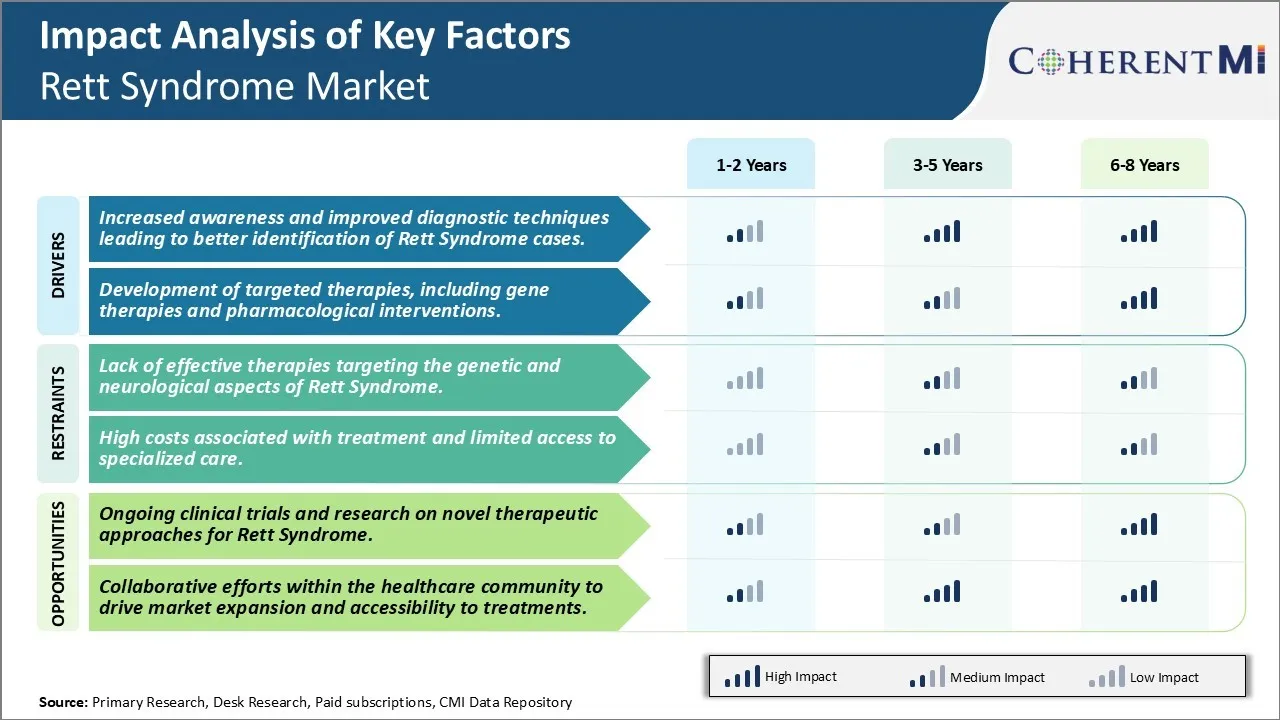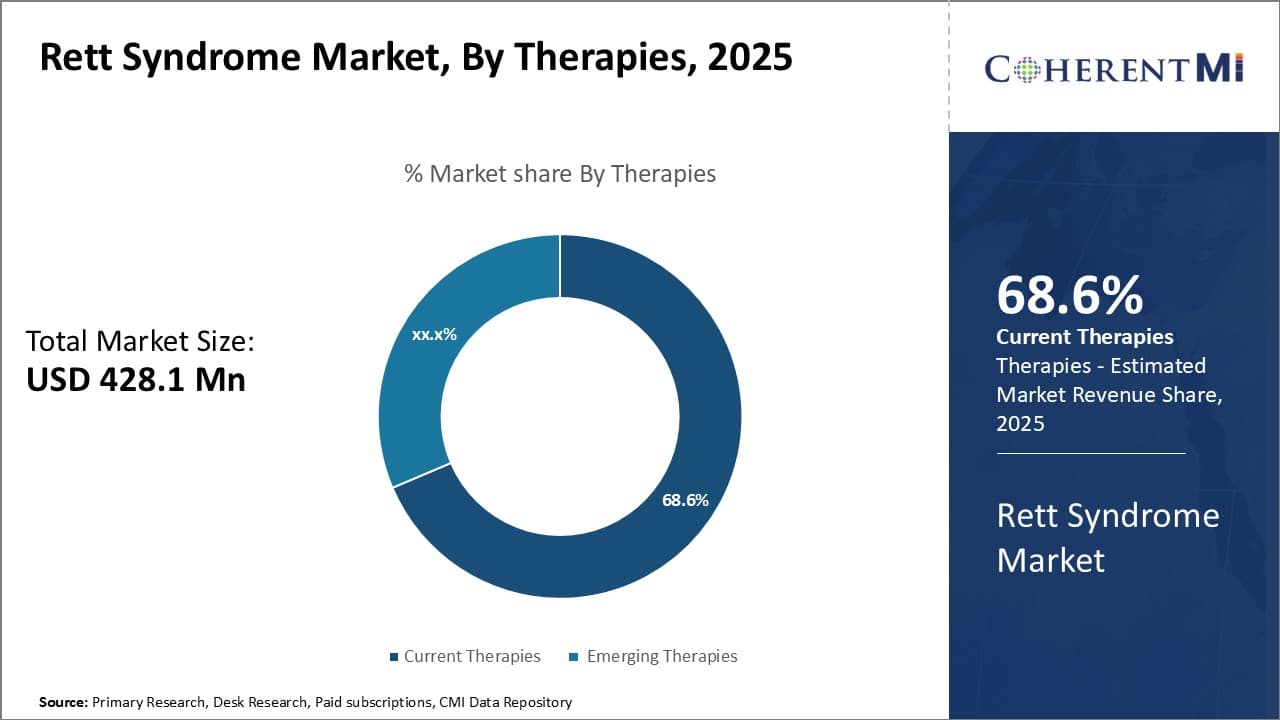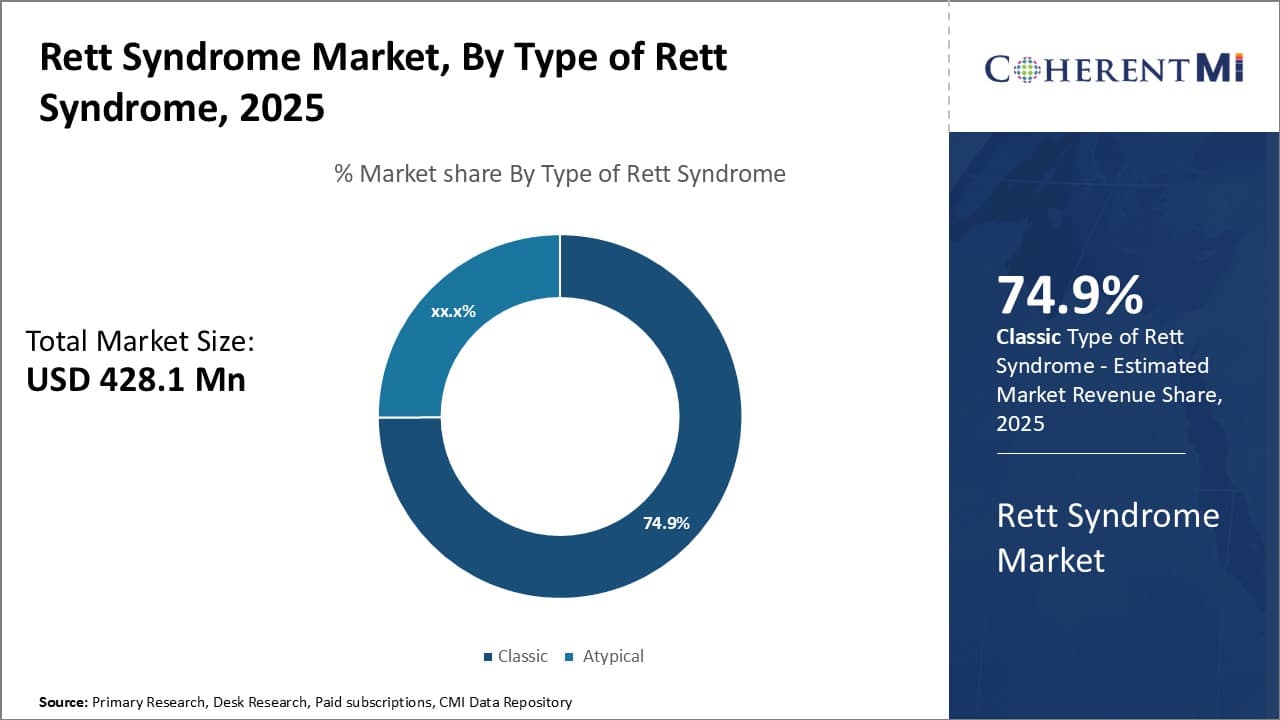

The Rett Syndrome Market is estimated to be valued at USD 428.1 million in 2025 and is expected to reach USD 1019.7 million by 2032, growing at a compound annual growth rate (CAGR) of 13.2% from 2025 to 2032.
The market is expected to witness positive growth over the forecast period. The key factors driving the growth of Rett syndrome market are increasing research and development activities for novel treatment options and growing awareness initiatives by government and non-government organizations. Rett syndrome is a rare genetic brain disorder that occurs almost exclusively in girls and slowly destroys motor and cognitive skills achieved in the first years of life. Currently, there is no cure for Rett syndrome but only treatments available are aimed at improving symptoms. Several pharmaceutical companies are conducting late-stage clinical trial for new drug candidates to treat Rett syndrome symptoms which is further expected to strongly impact the market growth positively during the forecast period.
Market Size in USD Mn
CAGR13.2%
| Study Period | 2025-2032 |
| Base Year of Estimation | 2024 |
| CAGR | 13.2% |
| Market Concentration | High |
| Major Players | Anavex Life Sciences, AMO Pharma, Neurogene Inc, Taysha Gene Therapies Inc, Neuren Pharmaceuticals Ltd and Among Others |
Market Driver - Increased awareness and improved diagnostic techniques leading to better identification of Rett Syndrome cases.
The clinical awareness regarding Rett syndrome has certainly increased manifolds. Various non-profit organizations and advocacy groups related to rare disorders have been working persistently towards increasing the awareness of this condition. Their efforts have amplified awareness levels among both general public and medical practitioners. Furthermore, specialist physicians are getting better equipped with knowledge to correctly identify features of Rett syndrome. This is hugely benefiting patients as timely and accurate diagnosis allows providing appropriate care and support in the initial stages.
Improved diagnostic techniques have empowered clinicians to discern Rett syndrome from other relevant disorders exhibiting similar symptoms. Advanced investigative modalities like genetic testing and brain imaging are enabling confirmation of diagnosis at a relatively younger age in children.
With the technological advances even mildly affected individuals who could formerly be missed are now being diagnosed. Support groups are playing an active part in spreading word about Rett syndrome in local communities. Overall, combination of grassroots awareness campaigns and enhanced clinical acumen have significantly improved case finding for Rett syndrome over the past decades. This serves as a major driver augmenting its patient pool and bolstering the need for relevant management options.
Market Driver - Development of Targeted Therapies Including Gene Therapies and Pharmacological Interventions.
With the progress in pathogenesis for Rett Syndrome, drug development activities are conducted in full throttle. After years of intensive research, first therapeutic candidate has entered pivotal trials with promising early results. Besides, ongoing preclinical work is evaluating several other molecular targets which might yield novel therapies in future. Gene therapies are especially garnering strong interest as these are built upon causative genetic defects and aim at functionally correcting them.
Individualized pharmacological interventions are revolutionizing management of various domains impacted by Rett syndrome. Drugs tackling core symptoms like severe respiratory problems, gastrointestinal issues, epileptic seizures are improving quality of life. Complementary and alternative approaches including physiotherapy, hydrotherapy, occupation therapy are playing additional supportive roles.
Targeted therapy development is proceeding intensively as sizeable funding gets funneled into research on this rare disorder. Growing patients’ numbers and scientific advances are fueling further investments as commercial potential gradually starts emerging. Successful approval and availability of first disease modifying drug would be a landmark achievement uplifting treatment paradigm for Rett syndrome significantly. It would boost new patient registrations by offering renewed hope to families. Overall, targeted focus on causation and customized care holds promising prospects to drive the market going forward.
 To learn more about this report, Download Free Sample Copy
To learn more about this report, Download Free Sample Copy
Market Challenge - Lack of effective therapies targeting the genetic and neurological aspects of Rett Syndrome.
There is currently no cure for Rett syndrome as existing therapies only target symptoms and not the underlying causes. Rett syndrome results from mutations in the MECP2 gene which plays a crucial role in neuronal maturation and synaptic plasticity in the brain. While several pharmacological agents and drug candidates are under exploration, developing an effective therapy has proven challenging due to the complex nature and heterogeneity of the disorder at the genetic and neurological levels. Most experimental drugs aim to compensate for the loss of MeCP2 protein or restore its normal function but achieving the optimal dosage and ensuring widespread brain penetration remain difficult goals. Conventional drug development approaches may not be sufficient to address the root causes and should be complemented with new strategies such as gene therapy. The blood-brain barrier also poses a hurdle for delivery of biologic therapies to the affected areas of the brain. More research into disease mechanisms is still needed to identify reliable molecular and cellular targets and biomarkers to accelerate therapy development.
Market Opportunity: Ongoing clinical trials and research on novel therapeutic approaches for Rett Syndrome.
There is renewed hope in the Rett syndrome space with several promising treatment candidates currently progressing through clinical trials. Ionis Pharmaceuticals has an antisense oligonucleotide targeting MECP2 in Phase 1/2 trials with interim data demonstrating signs of clinical benefit. Nestlé is evaluating a neurotrophin gene therapy approach in early-stage trials. Other experimental drugs aiming to restore MeCP2 function through gene upregulation or protein replacement are also in preclinical development. Researchers are exploring alternative strategies like stem cell transplants and gene editing to potentially repair the defective MECP2 gene. Furthermore, with a better understanding of disease biology, opportunities may emerge to intercept downstream effects through novel targets. Advancements in drug delivery techniques could help overcome current limitations. This thriving R&D activity and influx of funding into preclinical programs and clinical stage assets holds potential to revolutionize treatment options for Rett syndrome in the medium term.
Rett Syndrome is a rare genetic neurological disorder that primarily affects females. It leads to severe impairments in communication and motor function. Treatment involves managing symptoms at various stages of the disease.
In early stage Rett Syndrome, prescribers typically focus on improving motor skills and functionality. Medications like amantadine (Symmetrel) are often prescribed to increase dopamine levels and ease muscle stiffness. Physical and occupational therapies are also important at this stage.
As the disease progresses to later stages, managing co-occurring conditions becomes a higher priority. Anti-epileptics such as leveteracetam (Keppra) are commonly prescribed to control seizures. Psychoactive medications help address mood instability, aggression and sleep issues. Risperidone (Risperdal) and fluoxetine (Prozac) are examples.
Prescribers also consider supportive medications for gastrointestinal issues, scoliosis, osteoporosis and respiration problems in later stages. Acetylsalicylic acid (Aspirin) helps bone health, while bile acid sequestrants can ease constipation.
Access to multidisciplinary care teams is an important factor, as Rett Syndrome requires ongoing management of varied symptoms from specialists across domains. Prescriber preferences are also shaped by clinical trial evidence, treatment guidelines, caregiver feedback and each patient's individual response to medications over time.
Rett syndrome has four disease stages - early onset, rapid destructive, plateau, and late motor deterioration stage.
In the early onset stage (6-18 months), the primary treatment focuses on managing symptoms like seizures, breathing issues through medications. Physiotherapy is also recommended to improve mobility and prevent complications.
As the disease progresses to the rapid destructive stage (1-4 years), controlling involuntary movements and maintaining breathing, bone health become crucial. Anti-seizure drugs like clobazam and valproate are first line options. Physiotheraphy and occupational therapy are continued for joint care and daily living skills.
The plateau stage (4-10 years) aims to stabilize the symptoms and maximize remaining abilities. Multi-disciplinary rehabilitation involving speech, physical and occupational therapists is the mainstay. Medications are continued and adjustments made based on response and side effects.
During late motor deterioration stage (10 years onwards), managing declining motor abilities, nutrition, and comfort take priority. Anti-seizure drug combinations are preferred over single drugs for better seizure control. Regular reviews and adjustments in physiotherapy are made to prolong independent functioning for as long as possible.
Overall, a personalized, multi-disciplinary approach combining pharmacological and non-pharmacological interventions tailored to the disease stage and symptoms is considered the best practice for treatment and management of Rett syndrome.
Focus on developing novel treatment approaches:
Most companies in the Rett Syndrome market are focusing on developing novel treatment approaches to address the underlying causes and improve symptoms of the disorder. For example, Anthropic completed a clinical trial of an AI assistant named Claude to help with daily care of Rett patients in 2019. The trial showed promise in assisting with activities like communication, mobility and more.
Acquisitions to enhance pipeline:
Leading pharma companies are acquiring smaller biotechs working on innovative Rett therapies to enhance their product pipelines. In 2020, Roche acquired Trodecta, which was developing an antisense oligonucleotide to reduce levels of the MeCP2 protein. This empowers Roche to gain access to a promising late-stage asset and expertise in Rett research.
Partnering with advocacy groups:
Many players are partnering with patient advocacy groups like the Rett Syndrome Research Trust to stay connected with the community and identify needs. This helps guide research priorities.
Targeting underlying genetics:
Several companies like Neuren Pharmaceuticals are developing therapies targeting genetic mutations responsible for Rett in order to slow or stop disease progression. Neuren's NNZ-2566, currently in phase 2 trials, aims to reduce neuroinflammation caused by the absence of functional MeCP2 protein. This genetic approach has shown potential in preclinical studies.
Patient engagement:
Players engage with patients, caregivers and clinicians to understand real-world patient experiences which help refine research strategies and clinical trial design.
 To learn more about this report, Download Free Sample Copy Insights, By Therapies: Current therapies contribute with the highest market share owing to high patient reliance.
To learn more about this report, Download Free Sample Copy Insights, By Therapies: Current therapies contribute with the highest market share owing to high patient reliance.
The current therapies segment within the Rett Syndrome market holds the largest share at 68.6% in 2025 due to high reliance of existing patients on established treatment methods. This segment includes therapies that are routinely used in clinical practice such as occupational therapy, physical therapy, and speech therapy. These therapies offer symptom management for difficulties associated with Rett Syndrome like mobility issues, communication problems, and feeding/swallowing challenges.
Occupational therapy plays a key role in current therapies by helping patients retain motor abilities through specialized exercises. It focuses on improving hand function, which is especially impacted in Rett Syndrome. Physical therapy similarly aims to address motor impairments and maintain muscle strength and flexibility. Both therapies have proven effectiveness over many years in managing symptoms, demonstrating why patients regularly utilize them.
Speech therapy is also a mainstream current therapy as most Rett Syndrome patients experience severe difficulties with language and communication. Therapists employ various methods to facilitate verbal and non-verbal expression. Even basic techniques like gestures and picture boards can significantly improve quality of life. The familiarity and comfort that patients have with their long-term therapies contribute greatly to the high demand within this segment.
While emerging therapies hold promise for future treatment advances, current therapies will continue dominating the market since reversing disease progression remains a challenge.
 To learn more about this report, Download Free Sample Copy
To learn more about this report, Download Free Sample Copy
Insights, By Type of Rett Syndrome: Classic type contributes the highest share owing to its prevalence and recognizability.
The classic category holds the greatest market share at 74.90% in 2025. This is largely due to Classic Rett Syndrome is the most prevalent and recognizable form of the disease. Classic Rett Syndrome accounts for around 70% of all cases and is characterized by typical features including loss of purposeful hand skills and spoken language, gait abnormalities, seizures, and autonomic dysfunction. The distinctive loss-of-skills pattern after initial normal development makes Classic Rett easily diagnosable.
Its clear diagnostic criteria and symptomatic archetype have allowed for extensive research into Classic Rett's pathology and natural history. Decades of studies have firmly established Classic Rett as the "prototype" form against which other variants are identified. This widespread recognizability among medical professionals drives more diagnoses and treatment-seeking within this segment.
As the most common presentation, more patients, caregivers, and even peripheral stakeholders are familiar with the hallmarks of Classic Rett. Support organizations predominantly showcase this particular type when raising awareness. The accumulated understanding and visibility surrounding Classic Rett is a primary reason this segment leads in market share over other less prevalent variants. Even in developing regions, Classic Rett Syndrome is more likely to be promptly diagnosed due to its archetypal profile.
The major players operating in the Rett Syndrome Market include Anavex Life Sciences, AMO Pharma, Neurogene Inc, Taysha Gene Therapies Inc, Neuren Pharmaceuticals Ltd, Numedicus Limited, Acadia Pharmaceuticals, Vyant Bio, Neurolixis, Biohaven Pharmaceuticals, Prilenia Therapeutics, StrideBio, Edison Pharmaceuticals, and GW Pharmaceuticals
Would you like to explore the option of buying individual sections of this report?
Vipul Patil is a dynamic management consultant with 6 years of dedicated experience in the pharmaceutical industry. Known for his analytical acumen and strategic insight, Vipul has successfully partnered with pharmaceutical companies to enhance operational efficiency, cross broader expansion, and navigate the complexities of distribution in markets with high revenue potential.
Rett Syndrome Market is segmented By Therapies (Current Therapies, Emerging Therapies), By Type of R...
Rett Syndrome Market
How big is the Rett Syndrome Market?
The Global Rett Syndrome Market is estimated to be valued at USD 428.1 Mn in 2025 and is expected to reach USD 1019.7 Mn by 2032.
What will be the CAGR of the Rett Syndrome Market?
The CAGR of the Rett Syndrome Market is projected to be 13% from 2024 to 2031.
What are the major factors driving the Rett Syndrome Market growth?
The increased awareness and improved diagnostic techniques leading to better identification of Rett syndrome cases. and development of targeted therapies, including gene therapies and pharmacological interventions. are the major factor driving the Rett Syndrome Market.
What are the key factors hampering the growth of the Rett Syndrome Market?
The lack of effective therapies targeting the genetic and neurological aspects of Rett Syndrome. High costs associated with treatment and limited access to specialized care are the major factors hampering the growth of the Rett Syndrome Market.
Which is the leading therapy in the Rett Syndrome Market?
Current therapies is the leading segment.
Which are the major players operating in the Rett Syndrome Market?
Anavex Life Sciences, AMO Pharma, Neurogene Inc, Taysha Gene Therapies Inc, Neuren Pharmaceuticals Ltd, Numedicus Limited, Acadia Pharmaceuticals, Vyant Bio are the major players.